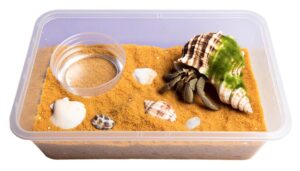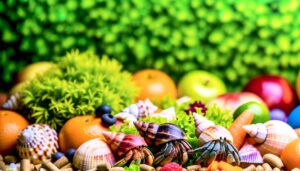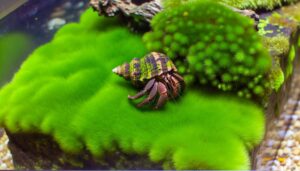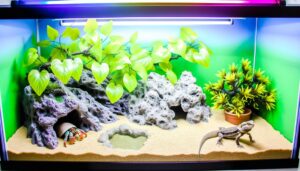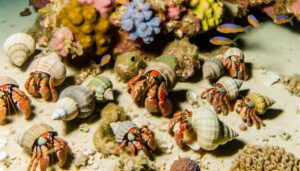Do Hermit Crabs Eat Worms in Their Diet?
Hermit crabs don't primarily eat wood, but they might nibble on it during their foraging activities. Their diet needs to be diverse, including fresh fruits, vegetables, and protein sources to meet nutritional needs.
Providing calcium sources like cuttlebone or crushed eggshells is important. In their natural habitat, they consume decaying plant material, which offers necessary nutrients.
Safe woods like grapevine, cork bark, and cholla wood can be used decoratively in their enclosures. Avoid cedar and pine due to harmful oils.
To ensure their well-being, mimicking their natural diet is essential. If you want to find out more, keep going.
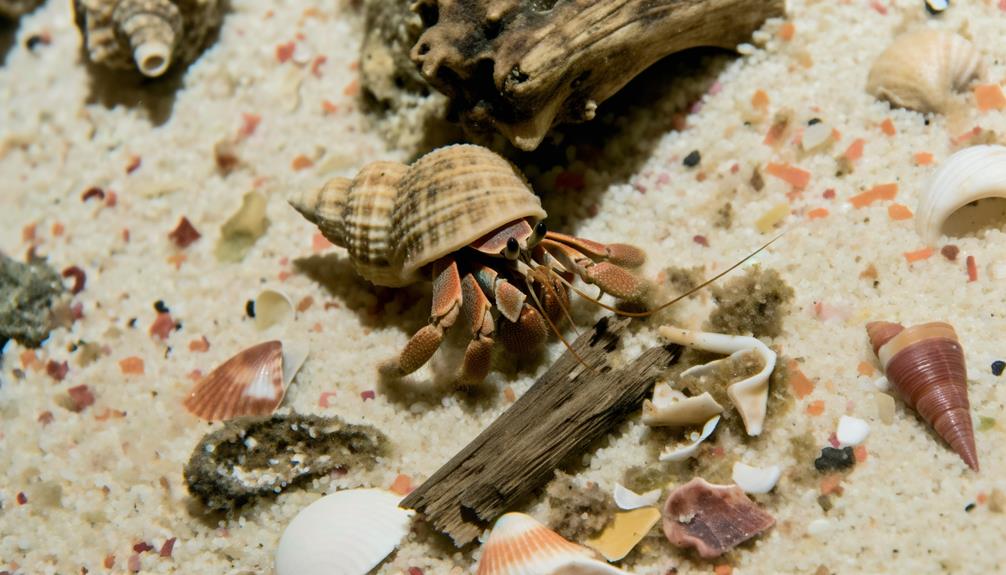
Key Takeaways
- Hermit crabs do not eat wood as a primary food source.
- Safe woods like grapevine and cholla can be used decoratively in enclosures.
- Wood is not a significant nutritional source for hermit crabs.
- Hermit crabs forage for decaying plant material, not wood, in the wild.
- Avoid cedar and pine wood due to harmful oils.
Hermit Crab Diet Basics
Understanding the dietary needs of hermit crabs is vital for ensuring their health and longevity. You should provide a variety of foods to meet their nutritional requirements. Hermit crabs are omnivores, meaning they thrive on a diet that includes both plant and animal matter.
You can offer them fresh fruits, vegetables, and protein sources like boiled eggs or fish. Additionally, commercial hermit crab food can supplement their diet, ensuring they receive essential vitamins and minerals. Calcium is essential for their exoskeleton development, so include sources like cuttlebone or crushed eggshells.
Regularly changing their food and water prevents mold and bacterial growth. By understanding their dietary basics, you'll help maintain their well-being and promote a long, healthy life.
Natural Habitat and Food Sources
In their natural habitats, hermit crabs forage for a wide variety of food sources including decaying wood, leaf litter, and small invertebrates. You'll find them scavenging along coastal regions where organic matter is plentiful.
Decomposing plant material provides essential nutrients and minerals, while small invertebrates add protein to their diet. Hermit crabs are opportunistic feeders, meaning they'll eat whatever is available to meet their dietary needs. Their foraging behavior plays a pivotal role in their ecosystem, aiding in decomposition and nutrient cycling.
Understanding their natural diet is key to replicating a balanced environment for them. By providing similar food sources, you can help maintain their health and well-being, ensuring they thrive under your care.
Wood in Hermit Crab Enclosures
When selecting wood for your hermit crab enclosure, you need to make sure it's both safe and non-toxic. Examine types like grapevine, cholla, and cork bark, which are generally considered safe.
Be aware of potential health risks from certain woods, such as cedar and pine, which can release harmful oils.
Types of Safe Wood
Why is it important to select specific types of wood for hermit crab enclosures to secure their safety and well-being? Certain woods contain toxins or oils that are harmful to hermit crabs. By choosing safe woods, you secure a non-toxic environment that supports their health.
Safe options include cork bark, cholla wood, and grapevine. Cork bark is naturally resistant to mold and provides excellent climbing surfaces. Cholla wood, derived from cacti, is porous and ideal for hermit crabs to explore. Grapevine offers a durable, natural aesthetic while being free from harmful substances.
Always avoid treated woods, pine, cedar, and fir, as these can release harmful chemicals. Opt for safe wood types to maintain a healthy and stimulating habitat for your hermit crabs.
Potential Health Risks
Selecting suitable wood types isn't just about enhancing the habitat's aesthetics; it's about mitigating potential health risks that can arise from toxic substances found in certain woods. Some woods release harmful compounds that can adversely affect your hermit crabs' health. For instance, woods like pine and cedar contain aromatic oils and phenols that can irritate the respiratory system and potentially cause long-term damage.
Consider the following risks:
- Respiratory Issues: Aromatic oils can lead to respiratory distress.
- Toxicity: Certain woods contain toxins that can be harmful if ingested.
- Mold Growth: Non-resistant woods can harbor mold, posing additional health hazards.
Always research and select woods that are proven safe for hermit crab enclosures to safeguard their well-being.
Nutritional Needs of Hermit Crabs
Understanding the nutritional needs of hermit crabs is crucial for safeguarding their health and longevity in captivity. Hermit crabs thrive on a diverse diet that mimics their natural habitat. They require proteins, calcium, carotenoids, and essential fatty acids. A balanced diet supports their exoskeleton growth, coloration, and overall well-being.
| Nutrient | Importance |
|---|---|
| Proteins | Muscle and tissue development |
| Calcium | Exoskeleton hardening |
| Carotenoids | Enhances shell color and health |
| Fatty Acids | Membrane function and energy source |
| Fiber | Digestive health |
Regularly rotating food items guarantees they receive a variety of nutrients, preventing deficiencies. Supplement their diet with commercial hermit crab food, fresh fruits, vegetables, and occasional protein sources to maintain a balanced intake.
Safe and Unsafe Foods
When determining the safe and unsafe foods for hermit crabs, the main focus should be on items that provide nutritional benefits without introducing harmful substances. Hermit crabs thrive on a diet rich in variety, mimicking their natural habitat.
Safe options include fresh fruits, vegetables, and protein sources. Fresh fruits such as apples, mangos, and bananas are excellent choices. Vegetables like carrots, spinach, and bell peppers provide essential vitamins. Protein sources like boiled eggs, fish, and shrimp support their growth and exoskeleton health.
Conversely, avoid foods high in salt, sugar, and artificial additives, as these can harm their delicate systems.
Alternatives to Wood
Hermit crabs can benefit from various alternatives to wood that still fulfill their dietary and environmental needs, ensuring they stay healthy and active. These alternatives provide essential nutrients and keep their habitats enriching. Consider the following options:
| Alternative | Nutritional Value | Environmental Benefit |
|---|---|---|
| Cuttlebone | High in calcium | Strengthens exoskeleton |
| Leaf litter | Fiber and trace minerals | Mimics natural habitat |
| Eggshells (crushed) | Calcium and protein | Encourages natural foraging |
| Seaweed | Iodine and vitamins | Adds humidity and texture |
Practical Feeding Tips
To guarantee your hermit crabs thrive, it's important to provide a balanced diet that includes both protein and calcium-rich foods.
You should offer a variety of safe food options such as fruits, vegetables, and specialized hermit crab pellets.
Regularly adjust feeding frequency based on their activity levels and monitor food intake to prevent overfeeding.
Balanced Diet Essentials
Maintaining a balanced diet for hermit crabs involves providing a variety of foods rich in calcium, protein, and essential nutrients. It's important to meet their nutritional needs for optimal health and shell growth. Focus on offering diverse food sources to mimic their natural habitat.
- Calcium-rich foods:
- Crushed eggshells, cuttlebone, and coral sand support shell development.
- Protein sources:
- Dried shrimp, bloodworms, and boiled chicken provide necessary amino acids.
- Fresh fruits and vegetables:
- Apples, carrots, and leafy greens offer vitamins and minerals.
Rotate these items regularly to keep your hermit crabs engaged and healthy. Avoid processed foods and make sure all offerings are free from pesticides.
Safe Food Options
For ensuring your hermit crabs receive safe and nutritious food, focus on offering organic options that are free from harmful chemicals and additives. Choose fresh fruits and vegetables, such as apples, carrots, and spinach, which provide essential vitamins and minerals.
Avoid processed foods, as they often contain preservatives and artificial ingredients that can harm your pets. Incorporate sources of protein like boiled eggs, unsalted nuts, and small portions of lean meat.
Additionally, offer calcium-rich foods like cuttlebone or crushed oyster shells to support shell health. Always wash food thoroughly to remove pesticides and contaminants.
Feeding Frequency Tips
Feeding your hermit crabs every other day guarantees they receive consistent nutrition without overloading their metabolic systems. This schedule secures they get the necessary nutrients while preventing dietary imbalances.
Always provide a variety of food to meet their diverse nutritional needs. Fresh fruits, vegetables, and protein sources like boiled eggs or fish should be staples.
- Fruits and Vegetables: Offer small, bite-sized pieces of apples, carrots, or spinach.
- Protein Sources: Include occasional treats of unsalted nuts or dried shrimp.
- Calcium Supplements: Supply crushed eggshells or cuttlebone to support shell health.
Monitoring their consumption patterns helps you adjust portions accordingly, securing no leftovers that could spoil.
Conclusion
Imagine your hermit crab scuttling across its sandy home, antennae twitching as it seeks out nourishing bites.
While they don't eat wood, providing a well-rounded diet—abundant in proteins, fruits, and vegetables—ensures their health and vigor.
Steer clear of harmful foods and offer substitutes like cuttlebone for calcium.
By grasping their natural diet and habitat, you can establish a flourishing environment, where your crab's shell is vibrant, and its movements are lively, reflecting peak well-being.

